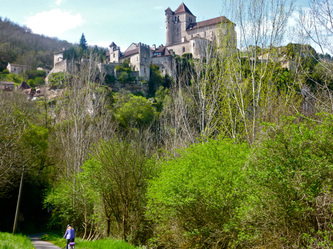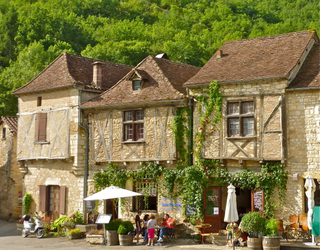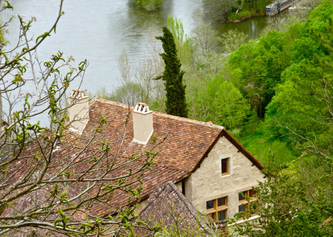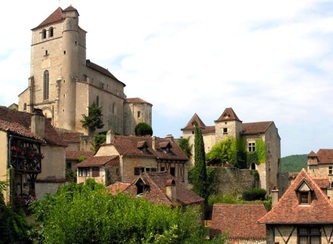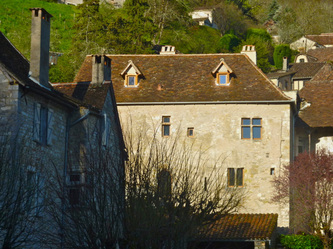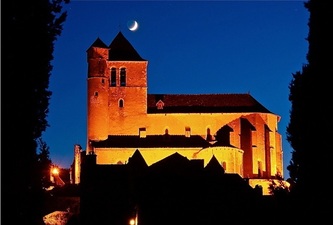"I long, as does every human being, to be at home wherever I find myself."
Maya Angelou
Maya Angelou
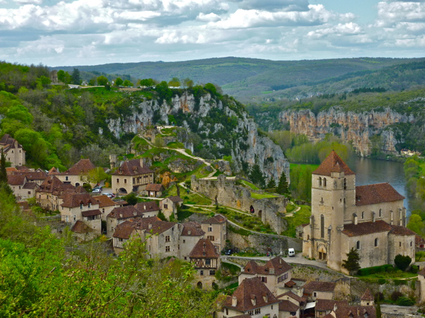
A view of the village from a hillside in April.
Between the Dordogne and Provence,
on a cliff overlooking a magnificent river valley, lies the lively, medieval village of St. Cirq Lapopie, a place Richard
the Lion-heart once failed to conquer.
As you stroll through the medieval gate, and view the layers of red-capped village houses, many of them garlanded with flowers, you'll feel a mesmerizing sense of an ancient world not yet disappeared.
But once past the old oak entryway of the house, you'll find yourself among all the essentials of contemporary living.
on a cliff overlooking a magnificent river valley, lies the lively, medieval village of St. Cirq Lapopie, a place Richard
the Lion-heart once failed to conquer.
As you stroll through the medieval gate, and view the layers of red-capped village houses, many of them garlanded with flowers, you'll feel a mesmerizing sense of an ancient world not yet disappeared.
But once past the old oak entryway of the house, you'll find yourself among all the essentials of contemporary living.
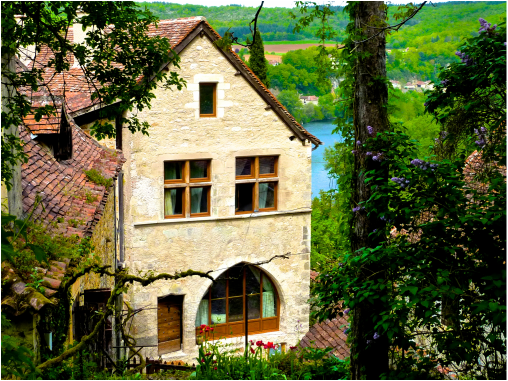 A view of the house in April.
A view of the house in April.
For many years, perhaps centuries, before the house renovation began in 2011, the building was considered a "ruin." (Why anyone in their right mind would take on the task of restoring a caved-in, centuries-old structure is a conversation to have over cognacs some evening.)
Shortly after the work began, it was determined that this 'ruin' was one of only a few historically 'listed' houses in the village. This meant it had to be restored to fairly high standards
-- the interior walls could not be modified, and the project had to be approved by the Batiment of France.
Nevertheless, with a talented builder and skilled local workers, the renovation proceeded at a good pace. That is, until the mayor noticed some error in the documentation and warned that the gendarmes would shut down the project if these bureaucratic issues weren't resolved. He was serious: so the work shut down and the workers went home for three months until the matter was finally settled.
Once resumed, the renovation was completed fairly quickly, remarkably given that communication between the owners and the builder took place almost entirely across the Atlantic via skype. The house is quite wonderful. And, thus far, we've all lived happily thereafter.
Shortly after the work began, it was determined that this 'ruin' was one of only a few historically 'listed' houses in the village. This meant it had to be restored to fairly high standards
-- the interior walls could not be modified, and the project had to be approved by the Batiment of France.
Nevertheless, with a talented builder and skilled local workers, the renovation proceeded at a good pace. That is, until the mayor noticed some error in the documentation and warned that the gendarmes would shut down the project if these bureaucratic issues weren't resolved. He was serious: so the work shut down and the workers went home for three months until the matter was finally settled.
Once resumed, the renovation was completed fairly quickly, remarkably given that communication between the owners and the builder took place almost entirely across the Atlantic via skype. The house is quite wonderful. And, thus far, we've all lived happily thereafter.
Photos (clockwise from top left): a) bicycling beneath the village in early spring; b) restaurants in the town square; c) a view of our
house from the hillside; d) another look at the village; e) a side view of our house; f) the historic cathedral on a summer night
house from the hillside; d) another look at the village; e) a side view of our house; f) the historic cathedral on a summer night
